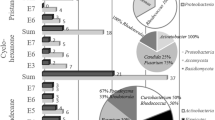Abstract
A yeast strain AEH was isolated from oil contaminated soil and identified by analysis of 18S and 26S ribosomal DNA sequences asPichia anomala. Strain AEH was capable of degrading naphthalene, phenanthrene and chrysene, singly, and benzo(a)pyrene in combination. The yeast degraded 5.36 mg naphthalene l−1 within 2 days, and 5.04 mg phenanthrene l−1 and 1.54 mg chrysene 1−1 within 10 days. When a mixture of the four polycyclic aromatic hydrocarbons (PAHs) was treated at a concentration between 2.98 mg l−1 and 6.89 mg l−1, degradation rates were delayed for naphthalene and phenanthrene (3.79 mg l−1 and, 4.20 mg l−1 within 10 days, respectively), but enhanced for chrysene and benzo(a)pyrene (3.37 mg l−1 and, 1.91 mg l−1 within 10 days, respectively). In a binary system, all of the other 3 PAHs could be utilized as the carbon source for the cometabolic degradation of benzo(a)pyrene with naphthale ne as the best one.
Similar content being viewed by others
References
Aitken M.D., Stringfellow T.W., Nagel D.R., Kazunga C., Chen S.H. (1998). Characteristics of phenanthrene-degrading bacteria isolated from soils contaminated with polycyclic aromatic hydrocarbons. Can. J. Microbiol., 44: 743–752.
Andres S., Andrezj M., Christian J., Aloys H. (1999). Degradation of fluorene, anthracene, phenanthrene, fluoranthene, and pyrene lacks connection to the production of extracellular enzymes byPleurotus ostreatus andBjerkandera adusta. Int. Biodeterior. Biodegrad., 43: 93–100.
Bossert I.D., Bartha R. (1986). Structure biodegradability relationships of polycyclic aromatic hydrocarbons in soil. Bull. Environ. Contam. Toxicol., 37: 490–495.
Cerniglia C.E., Crow S.A. (1981). Metabolism of aromatic hydrocarbons by yeasts. Arch. Microbiol., 129: 9–13.
Goldman R., Enewold L., Pellizzari E., Beach B.J., Bowman D.E., Krishnan S.S., Shields G.P. (2001). Smoking increase carcinogenic polycyclic aromatic hydrocarbons in human lung tissue. Cancer Res., 61: 6367–6371.
Harju S., Fedosyuk H., Peterson K.R. (2004). Rapid isolation of yeast genomic DNA: Bust n’ Grab. BMC Biotechnol., 4: 8.
Hofmann K.H. (1986). Oxidation of naphthalene bySaccharomyces cerevisiae andCandida utilis. J. Basic Microbiol., 26: 109–111.
Juhasz A.L., Naidu R. (2000). Bioremediation of high molecular weight polycyclic aromatic hydrocarbons: a review of the microbial degradation of benzo[a]pyrene. Int. Biodeterior. Biodegrad., 45: 57–88.
Kurtzman C.P., Robnett C.J. (1998). Identification and phylogeny of ascomycetous yeasts from analysis of nuclear large subunit (26S) ribosomal DNA partial sequences. Antoine van Leeuweenhoek, 73: 331–371.
Kurtzman C.P., Robnett C.J. (2003). Phylogenetic relationships among yeasts of theSaccharomyces complex determined from multigene sequence analyses. FEMS Yeast Res., 3: 417–432.
Leblond J.D., Schultz T.W., Sayler G.S. (2001). Observations on the preferential biodegradation of selected components of polyaromatic hydrocarbon mixtures. Chemosphere, 42: 333–343.
Lotfabad S.K., Gray M.R. (2002). Kinetics of biodegradation of mixtures of polycyclic aromatic hydrocarbons. Appl. Microbiol. Biotechnol., 60: 361–366.
Mastrangelo G., Fadda E., Marzia V. (1996). Polycyclic aromatic hydrocarbons and cancer in man. Environ. Health Perspect., 104: 1166–1170.
McGillivray A.R., Sharis M.P. (1993). Biotransformation of polycyclic aromatic hydrocarbons by yeasts isolation from coastal sediments. Appl. Environ. Microbiol., 59: 1613–1618.
McNally D.L., Mihelcic J.R., Lueking D.R. (1999). Biodegradation of mixtures of polycyclic aromatic hydrocarbons under aerobic and nitrate-reducing conditions. Chemosphere, 38: 1313–1321.
Ooi B.G., Mulisa A., Kim H.Y., Chong N.S. (2003). Methods development for the detection of trace metabolites from the biodegradation of polycyclic aromatic hydrocarbons by yeasts. J. Tennessee Acad. Sci., 78: 65–75.
Pan F., Yang Q., Zhang Y., Zhang S., Yang M. (2004). Biodegradation of polycyclic aromatic hydrocarbons byPichia anomala. Biotechnol. Lett., 26: 803–806.
Ren H., Zanma S., Urano N., Endo H., Mineki S., Hayashi T. (2004). Pyrene decomposing yeasts collected from sea water of Tokyo Bay. Nippon Suisan Gakkaishi, 70: 687–692.
Romero M.C., Cazau M.C., Giorgieri S., Arambarri A.M. (1998). Phenanthrene degradation by microorganisms isolated from a contaminated stream. Environ. Pollut., 101: 355–359.
Yang Q.X., Yang M., Pritsch K., Yediler A., Hagn A., Schloter M., Kettrup A. (2003). Decolorization of synthetic dyes and production of manganese-dependent peroxidase by new fungal isolates. Biotechnol. Lett., 25: 709–713.
Yuan S.Y., Wei S.H., Chang B.V. (2000). Biodegradation of polycyclic aromatic hydrocarbons by a mixed culture. Chemosphere, 41: 1463–1468.
Zinjarde S.S., Pant A.A. (2002). Hydrocarbon degraders from tropical marine environments. Mar. Pollut. Bull., 44: 188–121.
Author information
Authors and Affiliations
Corresponding author
Rights and permissions
About this article
Cite this article
Hesham, A.EL., Wang, Z., Zhang, Y. et al. Isolation and identification of a yeast strain capable of degrading four and five ring aromatic hydrocarbons. Ann. Microbiol. 56, 109–112 (2006). https://doi.org/10.1007/BF03174990
Received:
Accepted:
Issue Date:
DOI: https://doi.org/10.1007/BF03174990




